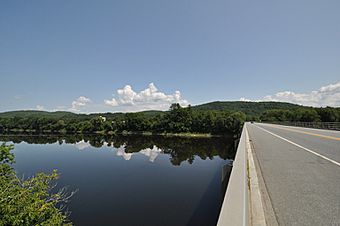Hunter Archeological Site facts for kids
Quick facts for kids |
|
|
Hunter Archeological Site
|
|

View of Claremont shore near the Ascutney bridge
|
|
| Lua error in Module:Location_map at line 420: attempt to index field 'wikibase' (a nil value). | |
| Location | near the mouth of the Sugar River at the Connecticut River, Claremont, New Hampshire |
|---|---|
| Area | 1 acre (0.40 ha) |
| Built | 1300 |
| NRHP reference No. | 76000222 |
| Added to NRHP | June 7, 1976 |
The Hunter Archeological Site is a very important place in Claremont, New Hampshire. It tells us a lot about Native American life long ago. This site is near a bridge that connects Claremont with Ascutney, Vermont.
Archaeologists have found seven different layers of history here. Each layer shows a different time when people lived on this land. They even found signs of at least three large homes called longhouses. The oldest things found here date back to the year 1300 AD. Because of its importance, the site was added to the National Register of Historic Places in 1976.
Discovering the Hunter Site
The Hunter Site is located on flat, raised areas of land called terraces. These terraces are found near the bridge between Claremont and Ascutney. When archaeologists dug into the ground, they found artifacts as deep as 11 feet (about 3.4 meters). These findings show that people lived here at seven different times in history.
A famous archaeologist named R. Duncan Mathewson said this site is special. He called it "one of the most complete records available" for understanding the Woodland period along the upper Connecticut River. The Woodland period was a time in Native American history from about 1000 BC to 1000 AD.
How the Site Was Found
The Hunter Site was first found by an archaeologist named Howard Sargent in 1952. Later, in 1967, Sargent did some special digging. This was called salvage archaeology. It means he quickly dug up artifacts that might have been damaged. This was important because a bridge was being built nearby.
In 1970, Sargent did a more complete dig near the bridge. During this work, he found many interesting things. These included pieces of pottery from the Late Woodland period. He also found burnt plant remains, which tell us what people ate.
What We Learned from the Site
Archaeologists also found evidence of burials at the site. They discovered signs of where longhouses once stood. Longhouses were big, long homes shared by many families. These discoveries suggest that the people who lived here were connected to Native American groups from the New York area.

